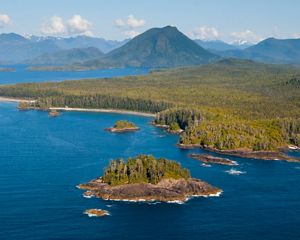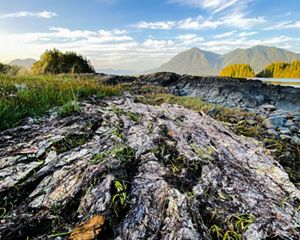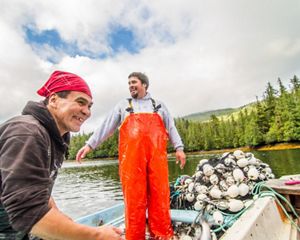
Emerald Edge Network Project Accelerator participants practice a movement to help receive the gifts of the event in Portland, Ore., April 2024. © Nikolaj Lasbo / TNC
“We have to look at the past to know where to go in the future,” said Ernie Michell, an Elder of the Kanaka Bar Indian Band, while nearly 50 Indigenous and community leaders from across the Emerald Edge sat in a circle at the Native American Student Center at the University of Portland.
Gathered on the traditional lands of the Multnomah, Kathlamet, Clackamas, Cowlitz bands of Chinook, Tualatin Kalapuya, Molalla and many other Tribes who made their homes along the Columbia River, Ernie Michell emphasized that the first responsibility was to give gratitude and to call in our ancestors to help us move through our work in a good way, which he did by offering a song with fellow Kanaka Bar Elders Pauline Michell and Wlwlmelst (Maurice Michell).

For the Emerald Edge Network, working with and following the guidance of Indigenous communities is a part of its original DNA. What ties the lands and waters of the largest remaining coastal temperate rainforest on Earth—which includes Southeast Alaska, British Columbia in Canada, and coastal Washington and Oregon—are the Tribes and First Nations that have stewarded them since time immemorial.
Reflections from the Writer
I silently gave gratitude to my ancestors, who swirl within me with every step I take, protect me everywhere I go and were welcomed into this space with every beat of the drum during songs sung in the circle. I am a Black Indigenous woman who is a descendent of the Jamestown S’Klallam Tribe on the Olympic Peninsula of Washington state. The land that was taken from my Indigenous ancestors is the same land that our current society was built on by my Black ancestors. In my professional life, I am conditioned to masking these two identities, conflating them into one or uplifting one over the other. In the sacred circle at the Emerald Edge Network Project Accelerator, all parts of me were seen and appreciated. It is sad to wrestle with the fact that this feeling is not commonplace for people like me in contemporary society.
Editor’s note: Look for more italicized reflections throughout the article from the writer, Monea Kerr.
At this event in April 2024, participants gathered for a Project Accelerator, which is an intensive network engagement designed to catalyze thinking and practice of Indigenous-led stewardship initiatives and to weave relationships between leaders across colonial borders. The goal was for project teams to leave feeling energized, optimistic and “un-stuck,” building connections and organic friendships to carry participants on the next phase of project journeys.

“There is an art to how we gather—based a little on network theory, a little on careful design and very much based on connections,” said Emerald Edge Network Director Mariana Velez. She went on to share that these are highly relational, highly diverse spaces of interaction. In these spaces, conservation outcomes are inevitable and the reach of the network snowballs, as those within the network bring others into their work, creating what Elder Ernie Michell described as “a hoop of many hoops.”
Reflections from the Writer
The benefits of the network come from being involved in the organic growth—an exponential growth—in connection, belonging and energy that overwhelms you in the best way. I experienced this overwhelm firsthand at my first Emerald Edge Network event in Portland, where I engaged in three days of relationship building, resource sharing and immense richness in wisdom and cultural exchange.
A Collective Approach to Problem-solving
The Project Accelerator wove plenary space where the entire group came together and each project spent time with a facilitator in a “gentle container,” as explained by KJ Heslin England, a member of the Salmon Parks Stewardship Society project team. Here, innovation, relationship, visioning, experience sharing and problem-solving meet. Because of this, a project can be anywhere in its lifespan, from an idea to a full-fledged initiative. Facilitators and knowledge weavers—who are network guests who provide additional insight—help to advance, nudge and inspire projects to the next level, whatever that means to each team.
Quote: Mariana Velez
There is an art to how we gather—based a little on network theory, a little on careful design and very much based on connections.

“We were able to dig into the important things that will inform our work,” said Amanda Bremner of the Yakutat Tlingit Tribe. Instead of being in a reactive space, her project team was enabled to think through a lens that ultimately led to clarity.
“It’s like we are one beehive, one big brain, one mind. All our ideas complement each other,” added Michelle Meyer of the Yakutat Tlingit Tribe.
Terry Dorward of the Tla-o-qui-aht Nation and president of the board for the IISAAK OLAM Foundation shared that Accelerator events provide an opportunity for project teams to step outside of the box and see their projects through the eyes of others. Dorward shared that much like when Elders get together, they do so in groups so they can be reminded through each other’s memories.

The Accelerator’s collective approach to problem-solving resonates with Dorward’s Indigenous ways of operating holistically and respectfully, meeting the needs of Indigenous Peoples as opposed to only operating in one way. “This event takes a holistic approach, which is how we operate as Indigenous Peoples,” he sa
Reflections from the Writer
Many project teams thought they came to the accelerator to focus on their own projects, but they ended up seeing value in so much more. After the event began, I soon realized the impact of the Network is even greater than I had imagined and even greater than is imaginable.
About the Emerald Edge Network
The Emerald Edge Network, hosted by The Nature Conservancy and its Canadian affiliate, Nature United, seeks to realize Indigenous-led and ally-supported land and water stewardship by accelerating precedent-setting initiatives and building capacity, support and belonging between leaders across colonial borders. Since 2017 and in collaboration with Reos Partners, the Network has been hosting biannual convenings—cross-regional gatherings focused on relationship building, knowledge exchange, skill development and project acceleration.
Each network gathering brings a new constellation of leaders into the space, inevitably changing the dynamic and gifts of resources and connection. The Nature Conservancy and Nature United act as the convener in these spaces to bring people together but allow the Network to “move with spirit,” as some Elders have taught us, listening and responding to what is alive for the leaders in the room.
Reflections from the Writer
Because of the nature of networks, they are never-ending, ever-growing, malleable and adaptive to the current need. This is meaningful and worthwhile work that takes time, which is something that is so precious as our lives pull us in many different directions. What was special was the way the gathering was designed to ground the group in togetherness, focusing our undivided attention inward and onto one another, taking time to listen intently and bask in the presence the community created. This is what the Emerald Edge Network does—it forges relationships across colonial boundaries to create an unparalleled space of vulnerability, connection and hard work.

‘In Every Chair a Leader’
One of the guiding principles shared on the first day of the accelerator was, “In every chair, a leader,” which set the tone for all to feel comfortable. Borrowed from the First Alaskans Institute , this agreement encourages everyone in the room to “bring their best selves forward with a solid foundation in their identity and knowledge.”
Those who usually don’t feel welcomed to speak up found their voice in this vulnerable and open space. Val Massie from Alaska-based nonprofit Spruce Root said, “Seeing people comfortable to lead in ways they haven’t before is really powerful.”

Amanda Bremner from the Yakutat Tlingit Tribe shared with the group a sentiment that further invited participants into their place in the circle: “I’m so grateful that you are here. Not only for your community, but for our communities, too. I’m grateful you brought yourselves into this space. That is such a beautiful gift."
From youth to Elders, those who joined the Project Accelerator represented all walks of life, banded together for the common goal of protecting Mother Earth. “I believe we are all here for the same reason,” said Kanaka Bar Elder Ernie Michell. “And that is to fight for the land, because we are the original caretakers—and this job was given to us by the Creator. We all have a duty, and it all starts at home.”
Ernie Michell went on to share that not only were we all brought here for the same reason, but that we are all meant to be here and were called here to share our dreams, our fights and to learn from one another. “We are here to be sure the next seven generations are proud that we sat in this sacred circle,” he said.
“We didn’t cross the borders. The borders crossed us,” Terry Dorward said as he spoke highly of the Yakutat Tlingit Tribe’s all-women project team. “I want to recognize the strength in you women. Thank you for that strength,” he said before putting out a call for a “Warrior Women” song to be brought into the space.
Kanaka Bar Elder Pauline Michell answered his call, introducing the song by stating the reality that women are the backbone of society and the essence of life, and thanking those women who left family and children behind to be at the Project Accelerator event. Those who knew the song joined in and raised a fist in the air, standing in strength and solidarity with the many warrior women who were present.

Elder Wlwlmelst (Maurice Michell) also encouraged us to share what we know and pass it on to future generations—so that our knowledge is not lost when our bodies leave this Earth. This sharing of history, knowledge and experience can serve as a guide as we move through our lives so that wisdom can become intergenerational and immortal.
Reflections from the Writer
Lessons like these from Elders are precious and should not be taken lightly. There is so much to be gained from the wisdom of Elders, and I grew up listening intently to my Elders’ words and stories with the knowledge that they were passing down important and intangible artifacts. They equip us with the past that is in front of us and are great reminders of the future that is on our backs.
Changing Conservation Practices
By honoring Indigenous knowledge and leadership and supporting Indigenous and community-led conservation, The Nature Conservancy (TNC) and Nature United seek to uplift Indigenous visions over lands and waters and the people supporting them. In this way, through each of its gatherings, the Emerald Edge Network aims to increase capacity, support and belonging to uplift a living culture of stewardship.
“Indigenous peoples on this continent were either landscape or seascape gardeners, and I see TNC helping people tend those gardens again,” said Mary Porter of the Yakutat Tlingit Tribe. Thus, the Yakutat Guardians program that was developed at the Project Accelerator could undertake “returning the land to ancestral descendants,” she said.

As Peter Hatch of the Confederated Tribe of Siletz Indians shared through a powerful drum song, a tremendous amount of energy is needed to disrupt structures that have been built to exclude, exploit and cause harm to Indigenous Peoples. A space that carefully and mindfully brings both Indigenous and non-Indigenous peoples together can be a place of healing while simultaneously working to disrupt the very systems that were created to encourage its divide. This is part of working in Right Relations—the act of renewal and healing while standing together in sacred space among Indigenous and non-Indigenous people.
Participants were encouraged to lead with relationships first—and to think of relationship building as an outcome rather than something extra. This is different from the white-dominant and transactional work environment that many people operating within colonial borders experience.
Reflections from the Writer
The strides made by the project teams at the Project Accelerator event mark an important step as we consider that The Nature Conservancy was founded on and still benefits from colonial land acquisitions. These harms have been perpetuated through failing to adequately understand, engage and incorporate the rights, needs and views of Indigenous Peoples. The Nature Conservancy has far to go to be in Right Relations with Indigenous Peoples, but opportunities like the one hosted by the Emerald Edge Network are where the ingredients can come together to sow the seeds of healing and reconciliation.
Closing the Circle
The final day of the Project Accelerator saw rain—offering a cleansing of the land and a sense of renewal and regeneration for attendees. Peter Hatch sealed our work with a song to the land, specifically Siletz lands in coastal Oregon. Project teams left with a renewed sense of purpose, individuals left with a centered sense of self and the larger group left with a collective sense of community.
In the closing circle and at the silent request of the Elders in the room, participants joined hands. Through the current of collective energy, attendees were reminded that they are not alone and this newfound community is here to support one another. As the circle dissolved, the Kanaka Bar Elders offered a joy song to uplift people as they go back home, encouraging them to shine bright lights to illuminate the world.
Reflections from the Writer
We left with the understanding that the Emerald Edge Network is not a thing—it is a feeling, a place and a memory. It is a way of being and a way of working to uplift Indigenous and local community leadership across a vast coastal temperate rainforest. The resonating beat of the drum still reverberates through me—and everyone else. It’s a connection that will be woven across borders, through waters and between peoples who are neighbors and now friends.
We Can’t Save Nature Without You
Sign up to receive regular updates from The Nature Conservancy.
Accelerator Project Teams
-
For the Kanaka Bar Indian Band in British Columbia, extensive logging and mining have changed the landscape of their homeland. Their project centers around creating an Indigenous Protected and Conserved Area (IPCA) to prevent future environmental harm and heal the damage already done in their territory through purchasing private lands, extinguishing mining and forestry, and establishing protections. Their long-term vision is to use their land guardian program to engage in real ecosystem restoration to heal the land and waterways that have been disturbed by forestry and plantations. Mary Jo Michell of the Kanaka Bar Indian Band shared, “It was amazing to be with our Elders and the Lands Team to see where we’re at and understand where we’re going to focus at home and be a good neighbor.”
-
The Mowachaht/Muchalaht First Nation created the Salmon Parks Stewardship Society to implement the most effective interventions around salmon habitat recovery by stopping old-growth logging. As a newly formed team, they are exploring how to localize the concept of IPCAs. Their project is rooted in the Nuu-chah-nulth principles and laws, “Hisukʔis cawaak” (everything is connected) and restoring a relationship with “ʔiisaak” with respect to relatives and “ʔuuʔaaluk,” which is the duty to care for the other relatives of the natural world.
-
The Jamestown S’Klallam Tribe has been working to re-acquire key pieces of property along their rivers to prioritize habitat by removing or upgrading infrastructure. Because most of their historic old-growth forest has been logged and farmed, the Tribe is working to find ways to regrow old growth. The Tribe received a grant from the State of Washington for rehabilitation of riparian areas and determining the feasibility of generating carbon offsets or credits from those areas or from other conservation land holdings. Their project is in the beginning stages, allowing them to bring lots of questions to the gathering.
-
The Washington Innovation Network began in the same spirit as the Emerald Edge Network, and works to bring coastal Tribes together. This Porject Accelerator saw an important historic gathering of participants from the Makah, Quileute and Quinault nations. “I’m just amazed at the energy in the building,” said James Jaime of the Quileute Tribe. “I look forward to the continued relationships.” When considering the gathering of these three Tribes at the same table, Bobby Whitener of the Squaxin Island Tribe shared, “Those are historic interactions. I have started to notice a healing in this space.”
-
As an ecological and cultural leader, the Confederated Tribes of Siletz Indians are working with The Nature Conservancy, the McKenzie River Trust and the MidCoast Watersheds Council to achieve its vision and reaquire its land in line with the Tribe’s priorities for salmon and tidal wetlands, among other values. The Project Accelerator brought these groups together to think strategically about where and how to move forward with future projects.
-
For the Yakutat Tlingit Tribe, they hope to build a guardianship program to foster stewardship of their lands after experiencing practices of clear-cutting within their ancestral territory of Yaakwdáat. They have a need for data so that as things continue to happen on their lands, they will have a voice. The Project Accelerator was their first opportunity to strategize what their Indigenous guardianship program would look like.


